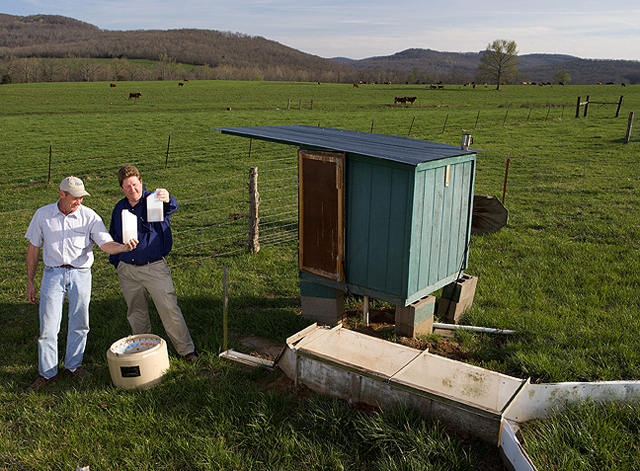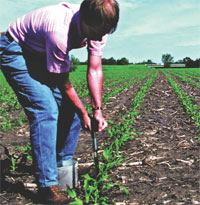-
Download:
My Results |
All BMPs
Phytase Feed Additive
 A newly designed phytase enzyme added to animal feed enables swine to use more phosphorus in the feed and excrete less of the phosphorus in their waste. Photo by Regis Lefebure. Photo courtesy of USDA ARS.
A newly designed phytase enzyme added to animal feed enables swine to use more phosphorus in the feed and excrete less of the phosphorus in their waste. Photo by Regis Lefebure. Photo courtesy of USDA ARS.
Practice Type: Management
Landuse/Agriculture Type: Animal Confinement
Climatic Zones: Temperate, Semiarid, Tropical
Regions: North America, South Asia, South America, Europe
Pollutants Treated: Phosphorus
Description: Phytase is an enzyme added to poultry-feed that helps poultry absorb phosphorus. The addition of phytase to poultry feed allows more efficient nutrient uptake by poultry, which in turn decreases the phosphorus levels in feed and in poultry waste. 1
Implementation Considerations: Phytase is sensitive to high temperatures and humidity, so proper storage and handling procedures are necessary to maintain the effectiveness of the product.
Scalable to small farms? Yes
Scaling Considerations: Where poultry feed is becoming wide spread, there is potential for this additive to become available, since there may be health benefits. See http://www.fao.org/docrep/013/al704e/al704e00.pdf
1 Estimates of County-level Nitrogen and Phosphorus Data for Use in Modeling Pollutant Reduction Documentation for Scenario Builder Version 2.2." Chesapeake Bay. Dec. 2010. Web. May 2013. http://archive.chesapeakebay.net/pubs/SB_V22_Final_12_31_2010.pdf.
Plant Tissue Analysis
 Ecologist David Spencer (right) and technician Greg Ksander collect an Arundo donax leaf sample for tissue nitrogen analysis. Photo by Peggy Greb. Photo Courtsey of USDA ARS.
Ecologist David Spencer (right) and technician Greg Ksander collect an Arundo donax leaf sample for tissue nitrogen analysis. Photo by Peggy Greb. Photo Courtsey of USDA ARS.
Practice Type: Management
Landuse/Agriculture Type: Row Crop
Climatic Zones: Temperate, Semiarid, Tropical
Regions: North America, South Asia, Europe
Pollutants Treated: Nitrogen, Phosphorus, Sediment
Description: Plant tissue analysis shows the nutrient status of plants at the time of sampling. This, in turn, shows whether soil nutrient supplies are adequate. The most important use of plant analysis is as a monitoring tool for determining the adequacy of current fertilization practices. Sampling a crop periodically during the season or once each year provides a record of its nutrient content that can be used through the growing season or from year to year. With soil test information and a plant analysis report, a producer can closely tailor fertilization practices to specific soil-plant needs.1
Implementation Considerations: Lab results and interpretations depend on the quality of the sample and the quality of the testing lab. Test costs in the United States are around $5 - $7 USD per sample. Applicability of this BMP will depend on proximity to qualified labs and extension services.
Scalable to small farms? No
Scaling Considerations: Will require training in sampling methods and the capacity to access quality labs. Lab results and interpretations depend on the quality of the sample and the quality of the testing lab. Test costs in the United States are around $5 - $7 USD per sample. Applicability of this BMP will depend on proximity to qualified labs and extension services.
1 Johnston, Adrian, Tom Jensen, David Franzen, and Jon Stika. "Fertilizer Best Management Practices: Suggested Practices for Semiarid North Dakota." International Plant Nutrition Institute (IPNI). Web. Jan. 2014. http://www.ipni.net/ipniweb/portal.nsf/0/9bbc50427c6469ae852574f200162796/$FILE/NGP BMP.pdf .
Poultry House Biofilters
 Biofilters, like this one at MU's South Farm, push air from a concentrated animal feeding operation through wood chips that filter out compounds that create the pungent odor in swine, poultry or dairy operations.
Photo credit: courtesy of Teng Teeh Lim/MU Commercial Agriculture Program.
Biofilters, like this one at MU's South Farm, push air from a concentrated animal feeding operation through wood chips that filter out compounds that create the pungent odor in swine, poultry or dairy operations.
Photo credit: courtesy of Teng Teeh Lim/MU Commercial Agriculture Program.
Practice Type: Structural, Management
Landuse/Agriculture Type: Animal Confinement
Climatic Zones: Temperate, Semiarid, Tropical
Regions: North America, South Asia, Europe, South America
Pollutants Treated: Nitrogen (Ammonia)
N Efficiency1: 60%
Description: Biofilters can be placed on poultry housing ventilation systems. They contain a media that incorporates a layer of organic material, typically a mixture of compost and wood chips that supports a microbial population and reduces ammonia emissions by oxidizing volatile organic compounds into carbon dioxide, water, and inorganic salts. Biofilters decrease nitrogen deposition from ammonia and the runoff of soluble phosphorus from land applied litter because of phosphorus sorption by alum. They also increase the proportion of nitrogen in manure. 2
Implementation Considerations: The biofilter must have sufficient detention time and fans that can accommodate pressure loss through the biofilter.
Scalable to small farms? No
Scaling Considerations: Not applicable for subsistance farms, but this low-cost, low tech practice has value for situations where poultry farming starts to move to a commercial scale, including the use of simple frames.
1 "Documentation: Source Data, BMP Effectiveness Values." Chesapeake Assessment Scenario Tool. Web. 2013. http://casttool.org/Documentation.aspx .
2 Estimates of County-level Nitrogen and Phosphorus Data for Use in Modeling Pollutant Reduction Documentation for Scenario Builder Version 2.2." Chesapeake Bay. Dec. 2010. Web. May 2013. http://archive.chesapeakebay.net/pubs/SB_V22_Final_12_31_2010.pdf.
Poultry Litter Treatment
 Technician Scott Becton (left) and soil scientist Philip Moore collect runoff water samples from a long-term paired watershed study being conducted in northwest Arkansas to measure phosphorus runoff from alum-treated poultry litter. Photo by Stephen Ausmus. Photo courtesy of USDA ARS.
Technician Scott Becton (left) and soil scientist Philip Moore collect runoff water samples from a long-term paired watershed study being conducted in northwest Arkansas to measure phosphorus runoff from alum-treated poultry litter. Photo by Stephen Ausmus. Photo courtesy of USDA ARS.
Practice Type: Management
Landuse/Agriculture Type: Animal Confinement
Climatic Zones: Temperate, Semiarid, Tropical
Regions: North America, South Asia, South America, Europe
Pollutants Treated: Phosphorus
N Efficiency1: 50%
Description: Poultry litter treatment can be treated with alum (aluminum sulfate) to bind the phosphorus in the litter and decrease the water soluble phosphorus that is prone to runoff. Alum treatment also reduces ammonia emissions. Alum can be applied in liquid or dry form to the manure at a rate of 5-10% by weight, usually between flocks. The treated litter has a higher nitrogen content, boosting crop yields, and has less phosphorus losses.2
Implementation Considerations: Individuals applying the alum should wear gloves, goggles and a dust mask when applying alum. Poultry houses must be kept well ventilated. Alum should be incorporated into the litter to prevent the birds from consuming it.
Scalable to small farms? No
Scaling Considerations: Constrained by availability of alum inputs.
1 "Documentation: Source Data, BMP Effectiveness Values." Chesapeake Assessment Scenario Tool. Web. 2013. http://casttool.org/Documentation.aspx .
2 Simpson, Thomas, and Sarah Weammert. "Developing Best Management Practice Definitions and Effectiveness Estimates for Nitrogen, Phosphorus and Sediment in the Chesapeake Bay Watershed." Chesapeake Bay Program. Dec. 2009. Web. June 2013. http://archive.chesapeakebay.net/pubs/BMP_ASSESSMENT_REPORT.pdf.
Pre-Sidedress Nitrogen Testing (PSNT)
Category: Nutrient management
Practice Type: Management
Landuse/Agriculture Type: Row Crop
Climatic Zones: Temperate, Semiarid, Tropical
Regions: North America
Pollutants Treated: Nitrogen
Description: Pre-Sidedress Nitrogen Testing (PSNT) is a soil test taken during the growing season that helps determine the optimal amount of nitrogen fertilizer application. A producer using PSNT would split their fertilizer application, applying a minimal amount of nitrogen in the spring. Soil samples for the PSNT test are taken during the growing season, after the typically wet spring period but prior to the crop’s major demand for nitrogen. The measured nitrate level in the soil, combined with a yield goal for the crop, are utilized to arrive at a recommended sidedress nitrogen rate, or possibly no additional nitrogen if adequate supplies are available in the soil. PSNT helps arrive at the right rate for N application resulting in better N use efficiency and producing optimum yields.
Implementation Considerations: PSNT is used primarily for corn production though has been useful for some vegetable crops. PSNT testing is most appropriate for fields with high organic content and is therefore applicable to fields where manure has been applied within the past 2 years or where corn is following a forage legume crop. PSNT requires access to lab services.
Scalable to small farms? No
Scaling Considerations: Applicability of this BMP will depend on proximity to qualified labs and extension services.
Practice Type: Management
Landuse/Agriculture Type: Row Crop
Climatic Zones: Temperate, Semiarid, Tropical
Regions: North America
Pollutants Treated: Nitrogen
Description: Pre-Sidedress Nitrogen Testing (PSNT) is a soil test taken during the growing season that helps determine the optimal amount of nitrogen fertilizer application. A producer using PSNT would split their fertilizer application, applying a minimal amount of nitrogen in the spring. Soil samples for the PSNT test are taken during the growing season, after the typically wet spring period but prior to the crop’s major demand for nitrogen. The measured nitrate level in the soil, combined with a yield goal for the crop, are utilized to arrive at a recommended sidedress nitrogen rate, or possibly no additional nitrogen if adequate supplies are available in the soil. PSNT helps arrive at the right rate for N application resulting in better N use efficiency and producing optimum yields.
Implementation Considerations: PSNT is used primarily for corn production though has been useful for some vegetable crops. PSNT testing is most appropriate for fields with high organic content and is therefore applicable to fields where manure has been applied within the past 2 years or where corn is following a forage legume crop. PSNT requires access to lab services.
Scalable to small farms? No
Scaling Considerations: Applicability of this BMP will depend on proximity to qualified labs and extension services.
